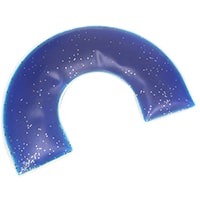Weighted vests are often recommended for children with autism. Usually they are recommended by a therapist to help a child focus in the classroom or calm down and sometimes to help with stereotypical behaviors, or stimming. Below are the answers to the most common questions our customers ask us about weighted vests.
Click Here to Shop for Weighted Vests >>
How much weight should the vest have?
While there are no studies on how much weight a vest should have, published studies on weighted vests have used from five to fifteen percent of a person's body weight.(1) This recommendation is based on therapist experience and also studies on maximum weight allowances for backpacks. Too much weight in a vest can result in over-stimulation and/or back injury.
How do weighted vests help students with autism or ADHD?
Weighted vests provide deep pressure across the neck and shoulders. Deep pressure has been shown to have a calming effect on ASD students. In a study with 10 ASD students both the teachers and aids, "reported that weighted vests were effective in improving classroom behaviors in all participants at least some of the time. All teachers and aides reported that weighted vests were appropriate modalities to use in the classroom and wanted to continue using weighted vests following the study. (6) In a random study of 110 children with ADHD researchers found that weighted vests did improve on task behavior. They stated that, "although wearing a weighted vest is not a cure-all strategy, our findings support the use of the weighted vest to remedy attentional and on-task behavioral problems of children with ADHD." (2)
How long should a child with autism wear a weighted vest?
Some therapists recommend as little as fifteen minutes while others encourage wearing them throughout the academic time in class. The positive benefits of a weighted vest usually happen while the child is wearing the vest. However, in cases where it is calming, often it can be taken off and the child will remain calm. Some therapists have expressed concern about students becoming "habituated" to wearing a vest. Meaning their body becomes so used to wearing the vest that it no longer is effective. Because of this concern they recommended that a student wear a weighted vest during specific activities that may require them to focus.
Do all children with autism need a weighted vest?
You should only use a weighted vest with a child when you are attempting to help them focus or calm down. They do not help all children because they can be uncomfortable and distracting for some. Pay attention when introducing one, especially if the child has significant communication challenges. Discontinue use if you see no benefit or it causes any distress. Various studies with smaller groups of students on the autism spectrum have had mixed results. They have been observed to improve on task behavior and help calming, but they do not help everyone. (1) Systematic reviews of the literature currently recommend more research. (3)
Do weighted vests decrease "stimming" or stereotypical behaviors?
Limited research is showing that weighted vests do not decrease stereotypical behaviors in children with autism or ADHD. A 2015 study using six students on the spectrum found that wearing a weighted vest did not decrease stereotyped behaviors in the classroom.(4) A study of children with ADHD found "no significant improvements in impulse control and automatic vocalizations." (2)
What kind of therapy is a weighted vest?
Weighted vests fall under the umbrella of Sensory Integration therapy. Sensory Integration therapy is usually performed by an Occupational Therapist trained in sensory integration. These therapists believe that inattentiveness and stereotypical behaviors are caused by over- or under-sensitivity to sensory input. Wearing a weighted vest provides deep pressure sensory input that helps with sensory difficulties. (5) Studies have shown that most students on the autism spectrum have statistically significant differences in sensory processing patterns. (7)
Can I make a weighted vest?
For those who don't sew, start by shopping at a thrift store or sporting goods store for a small fishing vest. If you sew, you can modify a vest by adding pockets either inside or outside the vest for weights. Next add weight to the pockets with bean bags or modeling clay. Remember to remove the weights before washing. Please remember to consult with a therapist to make sure you add the appropriate amount of weight.
Click Here to Shop for Weighted Vests >>
1. Béatrice Ouellet, Emmanuelle Carreau, Valérie Dion, Anouk Rouat, Elyse Tremblay, Julien I A Voisin. Efficacy of Sensory Interventions on School Participation of Children With Sensory Disorders: A Systematic Review. Am J Lifestyle Med. 2018 Jul 11;15(1):75-83.
2. Hung-Yu Lin, Posen Lee, Wen-Dien Chang, Fu-Yuan Hong. Effects of weighted vests on attention, impulse control, and on-task behavior in children with attention deficit hyperactivity disorder. Am J Occup Ther. Mar-Apr 2014;68(2):149-58.
3. Jane Case-Smith, Lindy L Weaver, Mary A Fristad. A systematic review of sensory processing interventions for children with autism spectrum disorders. Am J Occup Ther. Mar-Apr 2014;68(2):149-58.
4. Hodgetts S, Magill-Evans J, Misiaszek JE. Weighted vests, stereotyped behaviors and arousal in children with autism. J Autism Dev Disord. 2001;41:805-814.
5. Lana Bestbier, Tim I Williams. The Immediate Effects of Deep Pressure on Young People with Autism and Severe Intellectual Difficulties: Demonstrating Individual Differences. Occup Ther Int. 2017 Jan 9;2017:7534972.
6. Hodgetts S, Magill-Evans J, Misiaszek J. Effects of weighted vests on classroom behavior for children with autism and cognitive impairments. Res Autism Spectr Disord. 2011;5:495-505.
7. Ana Gentil-Gutiérrez, José Luis Cuesta-Gómez, Paula Rodríguez-Fernández, Jerónimo Javier González-Bernal. Implication of the Sensory Environment in Children with Autism Spectrum Disorder: Perspectives from School. Int J Environ Res Public Health. 2021 Jul 19;18(14):7670.



